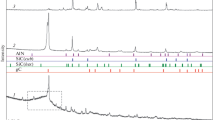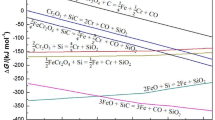Abstract
The formation of silicon carbide from briquetted batch consisting of microsilica waste from silicon and silicon-alloy production is investigated. The batch is treated at 1873, 1923, and 1973 K, for 5–30 min, with various reducing agents: lignite semicoke, coal semicoke, coke breeze, and coke dust. The best results are obtained when using lignite semicoke from the Berezovsk deposit in Kansko-Achinsk Basin: the yield of silicon carbide is 97.00–97.62%; it constitutes 82.52–84.90% of the products obtained. The optimal treatment temperature and time are determined: 1923–1973 K for 15–20 min. The products consist predominantly of cubic silicon carbide (β SiC). Chemical enrichment increases the SiC content in the products to 90–91%; this is higher than in abrasive micropowder of grain size 1–2 μm. The effectiveness of enrichment in terms of oxide and iron impurities is high: 87–95%. The silicon carbide is characterized by a high silica content: more than 7%. Accordingly, it may be regarded as a promising material for the production of siliconcarbide refractories used in silica binder. Silicon carbide is obtained as micropowder with irregular particles in the size range 0.2–1.0 μm.
Similar content being viewed by others
References
Garshin, A.P., Shumyacher, V.M., and Pushkarev, O.I., Abrazivy i materialy konstruktsionnogo naznacheniya na osnove karbida kremniya (Abrasives and Materials of Constructional Appointment on the Basis of Silicon Carbide), Volgograd: Volgograd. Gos. Arkhitekht.Stroit. Univ., 2008.
Rudneva, V.V., Nanomaterialy i nanotekhnologii v proizvodstve karbida kremniya: monografiya. Plazmometallurgicheskoe proizvodstvo karbida kremniya: razvitie teorii i sovershenstvovanie tekhnologii (Nanomaterials and Nanotechnologies in Production of Carbide of Silicon: Monograph. Plasma Metallurgical Production of Carbide of Silicon: Development of the Theory and Improvement of Technology), Moscow: Nauka, 2008.
Umanskii, A.P., Dushko, O.V., and Pushkarev, O.I., Composite wearproof materials on the basis of silicon carbide, Ogneupory Tekhn. Keram. 2009, no. 2, pp. 22–24.
Polyakh, O.A. and Yakushevich, N.F., Assessment of opportunity and expediency of use the fi ne containing silica materials in recovery processes, Vestn. GornoMetallurg. Sekts. Ross. Akad. Estesvennykh Nauk. Otd. Metall., 1999, no. 8, pp. 29–40.
Zubov, V.L. and Gasik, M.I., Elektrometallurgiya ferrosilitsiya (Ferrosilicium Electrometallurgy), Dnepropetrovsk: Sistemnye Tekhnologii, 2002.
Yakushevich, N.F. and Polyakh, O.A., Technology of coal thermal synthesis of silicon carbide micropowders, in Novye materialy i tekhnologii (New Materials and Technologies), Moscow: Mosk. Gos. Aviats.-Tekhnol. Univ., 1994, pp. 32–35.
Dinel’t, V.M. and Livenets, V.I., USSR Inventor’s Certificate no. 1730035, Byull. Izobret., 1992, no. 22.
Strakhov, V.M., Problems with carbon materials in ore and chemical electrofurnaces, Coke Chem., 2010, vol. 53, no. 8, pp. 301–304.
Strakhov, V.M., Alternative carbon reducing agents for ferroalloy production, Coke Chem., 2009, vol. 52, no. 1, pp. 19–22.
Islamov, S.R., Processing of low-grade coals into highcalorific fuel, Ugol’, 2012, no. 3, pp. 64–66.
Ulanovskii, M.L., Formation of the set properties of a carbonaceous reducer for electrothermal processes, Koks Khim., 2000, no. 4, pp. 14–20.
Nefedov, P.Ya., About requirements to quality of carbonaceous reducers for processes of an ore electrothermie, Koks Khim., 2000, no. 8, pp. 24–32.
Isakov, V.P., Yudina, K.S., and Filippov, Yu.A., RF Patent 2060935, Byull. Izobret., 1996, no. 24.
Galevskii, G.V., Rudneva, V.V., and Galevskii, S.G., Features of application of traditional methods of research of physical chemical and technological properties of refractory carbides and borides for certification of their high-disperse state, Vestn. Gorno-Metallurg. Sekts. Ross. Akad. Estesvennykh Nauk. Otd. Metall., 2003, no. 12, pp. 78–86.
Rudneva, V.V. and Galevskii, G.V., Thermooxidative stability of refractory carbide and boride nanpopowder, Steel Transl., 2007, vol. 37, no. 4, pp. 329–332.
Author information
Authors and Affiliations
Corresponding author
Additional information
Original Russian Text © A.E. Anikin, G.V. Galevskii, V.V. Rudneva, 2016, published in “Izvestiya VUZ. Chernaya Metallurgiya,” 2016, No. 2, pp. 105–111.
About this article
Cite this article
Anikin, A.E., Galevskii, G.V. & Rudneva, V.V. Formation of silicon carbide from microsilica waste by means of lignite semicoke. Steel Transl. 46, 93–98 (2016). https://doi.org/10.3103/S0967091216020029
Received:
Published:
Issue Date:
DOI: https://doi.org/10.3103/S0967091216020029




